Effect of Salinity on Cr(VI) Bioremediation by Algal-Bacterial Aerobic Granular Sludge Treating Synthetic Wastewater
Abstract
:1. Introduction
2. Materials and Methods
2.1. Experimental Design and Operation
2.2. Synthetic Wastewater and Seed Mature Algal-Bacterial Granules
2.3. Analytical Methods
2.4. Statistical Analysis
3. Results and Discussion
3.1. Changes in Characteristics of Algal-Bacterial AGS in the Two Reactors
3.1.1. Morphology and Granule Size
3.1.2. Granular Biomass Growth and Settleability
3.1.3. Granular Stability and Chl-a Content
3.2. Performance of the Two Reactors
3.2.1. Organics Removal
3.2.2. Nitrogen Removal
3.2.3. Phosphorus Removal
3.2.4. Chromium Removal
3.3. EPS Secretion from Algal-Bacterial Granules
4. Conclusions
Supplementary Materials
Author Contributions
Funding
Institutional Review Board Statement
Informed Consent Statement
Data Availability Statement
Acknowledgments
Conflicts of Interest
References
- Sartore, L.; Dey, K. Preparation and heavy metal ions chelating properties of multifunctional polymer-grafted silica hybrid materials. Adv. Mater. Sci. Eng. 2019, 2019, e7260851. [Google Scholar] [CrossRef] [Green Version]
- Gibb, H.J.; Lees, P.S.; Pinsky, P.F.; Rooney, B.C. Lung cancer among workers in chromium chemical production. Am. J. Ind. Med. 2000, 38, 115–126. [Google Scholar] [CrossRef]
- Zhitkovich, A. Chromium in drinking water: Sources, metabolism, and cancer risks. Chem. Res. Toxicol. 2011, 24, 1617–1629. [Google Scholar] [CrossRef]
- Tumolo, M.; Ancona, V.; De Paola, D.; Losacco, D.; Campanale, C.; Massarelli, C.; Uricchio, V.F. Chromium pollution in european water, sources, health risk, and remediation strategies: An overview. Int. J. Environ. Res. Public. Health 2020, 17, 5438. [Google Scholar] [CrossRef]
- Mitra, S.; Sarkar, A.; Sen, S. Removal of chromium from industrial effluents using nanotechnology: A review. Nanotechnol. Environ. Eng. 2017, 2, 11. [Google Scholar] [CrossRef]
- Brasili, E.; Bavasso, I.; Petruccelli, V.; Vilardi, G.; Valletta, A.; Bosco, C.D.; Gentili, A.; Pasqua, G.; Di Palma, L. Remediation of hexavalent chromium contaminated water through zero-valent iron nanoparticles and effects on tomato plant growth performance. Sci. Rep. 2020, 10, 1920. [Google Scholar] [CrossRef] [PubMed]
- Fu, F.; Wang, Q. Removal of heavy metal ions from wastewaters: A review. J. Environ. Manag. 2011, 92, 407–418. [Google Scholar] [CrossRef] [PubMed]
- Pushkar, B.; Sevak, P.; Parab, S.; Nilkanth, N. Chromium pollution and its bioremediation mechanisms in bacteria: A review. J. Environ. Manag. 2021, 287, 112279. [Google Scholar] [CrossRef] [PubMed]
- Joseph, L.; Jun, B.-M.; Flora, J.R.V.; Park, C.M.; Yoon, Y. Removal of heavy metals from water sources in the developing world using low-cost materials: A review. Chemosphere 2019, 229, 142–159. [Google Scholar] [CrossRef]
- Zabochnicka-Świątek, M.; Krzywonos, M. Potentials of biosorption and bioaccumulation processes for heavy metal removal. Pol. J. Environ. Stud. 2014, 23, 551–561. [Google Scholar]
- Ashraf, S.; Naveed, M.; Afzal, M.; Ashraf, S.; Rehman, K.; Hussain, A.; Zahir, Z.A. Bioremediation of tannery effluent by cr- and salt-tolerant bacterial strains. Environ. Monit. Assess. 2018, 190, 716. [Google Scholar] [CrossRef]
- Zeng, Q.; Hu, Y.; Yang, Y.; Hu, L.; Zhong, H.; He, Z. Cell envelop is the key site for Cr(Ⅵ) reduction by oceanobacillus oncorhynchi w4, a newly isolated Cr(Ⅵ) reducing bacterium. J. Hazard. Mater. 2019, 368, 149–155. [Google Scholar] [CrossRef]
- U.S. Environmental Protection Agency. Engineered Approaches to in Situ Bioremediation of Chlorinated Solvents: Fundamentals and Field Applications; U.S. Environmental Protection Agency: Washington, DC, USA, 2000. [Google Scholar]
- Yang, X.; Zhao, Z.; Yu, Y.; Shimizu, K.; Zhang, Z.; Lei, Z.; Lee, D.-J. Enhanced biosorption of Cr(VI) from synthetic wastewater using algal-bacterial aerobic granular sludge: Batch experiments, kinetics and mechanisms. Sep. Purif. Technol. 2020, 251, 117323. [Google Scholar] [CrossRef]
- Yang, X.; Zhao, Z.; Zhang, G.; Hirayama, S.; Nguyen, B.V.; Lei, Z.; Shimizu, K.; Zhang, Z. Insight into Cr(VI) biosorption onto algal-bacterial granular sludge: Cr(VI) bioreduction and its intracellular accumulation in addition to the effects of environmental factors. J. Hazard. Mater. 2021, 414, 125479. [Google Scholar] [CrossRef]
- Stasinakis, A.S.; Thomaidis, N.S.; Mamais, D.; Papanikolaou, E.C.; Tsakon, A.; Lekkas, T.D. Effects of chromium (VI) addition on the activated sludge process. Water Res. 2003, 37, 2140–2148. [Google Scholar] [CrossRef]
- Minhas, A.K.; Hodgson, P.; Barrow, C.J.; Adholeya, A. A review on the assessment of stress conditions for simultaneous production of microalgal lipids and carotenoids. Front. Microbiol. 2016, 7, 546. [Google Scholar] [CrossRef] [PubMed] [Green Version]
- Huang, W.; Cai, W.; Huang, H.; Lei, Z.; Zhang, Z.; Tay, J.H.; Lee, D.-J. Identification of inorganic and organic species of phosphorus and its bio-availability in nitrifying aerobic granular sludge. Water Res. 2015, 68, 423–431. [Google Scholar] [CrossRef] [Green Version]
- Wang, J.; Lei, Z.; Tian, C.; Liu, S.; Wang, Q.; Shimizu, K.; Zhang, Z.; Adachi, Y.; Lee, D.-J. Ionic response of algal-bacterial granular sludge system during biological phosphorus removal from wastewater. Chemosphere 2021, 264, 128534. [Google Scholar] [CrossRef] [PubMed]
- APHA. Standard Methods for the Examination of Water and Wastewater; American Public Health Association, American Water Work Association and Water Environment Federation: Washington, DC, USA, 2012. [Google Scholar]
- Wang, Q.; Shen, Q.; Wang, J.; Zhang, Y.; Zhang, Z.; Lei, Z.; Shimizu, K.; Lee, D.-J. Fast cultivation and harvesting of oil-producing microalgae ankistrodesmus falcatus var. Acicularis fed with anaerobic digestion liquor via biogranulation in addition to nutrients removal. Sci. Total Environ. 2020, 741, 140183. [Google Scholar] [CrossRef]
- Zhao, Z.; Yang, X.; Cai, W.; Lei, Z.; Shimizu, K.; Zhang, Z.; Utsumi, M.; Lee, D.-J. Response of algal-bacterial granular system to low carbon wastewater: Focus on granular stability, nutrients removal and accumulation. Bioresour. Technol. 2018, 268, 221–229. [Google Scholar] [CrossRef] [PubMed]
- Li, X.; Luo, J.; Guo, G.; Mackey, H.R.; Hao, T.; Chen, G. Seawater-based wastewater accelerates development of aerobic granular sludge: A laboratory proof-of-concept. Water Res. 2017, 115, 210–219. [Google Scholar] [CrossRef]
- Meng, F.; Liu, D.; Huang, W.; Lei, Z.; Zhang, Z. Effect of salinity on granulation, performance and lipid accumulation of algal-bacterial granular sludge. Bioresour. Technol. Rep. 2019, 7, 100228. [Google Scholar] [CrossRef]
- Dong, X.; Zhao, Z.; Yang, X.; Lei, Z.; Shimizu, K.; Zhang, Z.; Lee, D.-J. Response and recovery of mature algal-bacterial aerobic granular sludge to sudden salinity disturbance in influent wastewater: Granule characteristics and nutrients removal/accumulation. Bioresour. Technol. 2021, 321, 124492. [Google Scholar] [CrossRef]
- Meng, F.; Huang, W.; Liu, D.; Zhao, Y.; Huang, W.; Lei, Z.; Zhang, Z. Application of aerobic granules-continuous flow reactor for saline wastewater treatment: Granular stability, lipid production and symbiotic relationship between bacteria and algae. Bioresour. Technol. 2020, 295, 122291. [Google Scholar] [CrossRef]
- Wang, X.; Dai, H.; Zhang, J.; Yang, T.; Chen, F. Unraveling the long-term effects of Cr(VI) on the performance and microbial community of nitrifying activated sludge system. Water 2017, 9, 909. [Google Scholar] [CrossRef] [Green Version]
- Bassin, J.P.; Pronk, M.; Muyzer, G.; Kleerebezem, R.; Dezotti, M.; van Loosdrecht, M.C.M. Effect of elevated salt concentrations on the aerobic granular sludge process: Linking microbial activity with microbial community structure. Appl. Environ. Microbiol. 2011, 77, 7942–7953. [Google Scholar] [CrossRef] [PubMed] [Green Version]
- Shukla, A.; Zhang, Y.-H.; Dubey, P.; Margrave, J.L.; Shukla, S.S. The role of sawdust in the removal of unwanted materials from water. J. Hazard. Mater. 2002, 95, 137–152. [Google Scholar] [CrossRef]
- Yao, L.; Ye, Z.; Tong, M.; Lai, P.; Ni, J. Removal of Cr3+ from aqueous solution by biosorption with aerobic granules. J. Hazard. Mater. 2009, 165, 250–255. [Google Scholar] [CrossRef] [PubMed]
- Yang, X.; Zhao, Z.; Nguyen, B.V.; Hirayama, S.; Tian, C.; Lei, Z.; Shimizu, K.; Zhang, Z. Cr(VI) bioremediation by active algal-bacterial aerobic granular sludge: Importance of microbial viability, contribution of microalgae and fractionation of loaded Cr. J. Hazard. Mater. 2021, 418, 126342. [Google Scholar] [CrossRef]
- Fang, J.; Su, B.; Sun, P.; Lou, J.; Han, J. Long-term effect of low concentration Cr(VI) on p removal in granule-based enhanced biological phosphorus removal (EBPR) system. Chemosphere 2015, 121, 76–83. [Google Scholar] [CrossRef]
- Lin, H.; Ma, R.; Hu, Y.; Lin, J.; Sun, S.; Jiang, J.; Li, T.; Liao, Q.; Luo, J. Reviewing bottlenecks in aerobic granular sludge technology: Slow granulation and low granular stability. Environ. Pollut. 2020, 263, 114638. [Google Scholar] [CrossRef]
- Wan, C.; Yang, X.; Lee, D.-J.; Liu, X.; Sun, S.; Chen, C. Partial nitrification of wastewaters with high nacl concentrations by aerobic granules in continuous-flow reactor. Bioresour. Technol. 2014, 152, 1–6. [Google Scholar] [CrossRef]
- Corsino, S.F.; Capodici, M.; Torregrossa, M.; Viviani, G. Physical properties and extracellular polymeric substances pattern of aerobic granular sludge treating hypersaline wastewater. Bioresour. Technol. 2017, 229, 152–159. [Google Scholar] [CrossRef] [PubMed]
- Wang, Z.; Gao, M.; Wang, S.; Xin, Y.; Ma, D.; She, Z.; Wang, Z.; Chang, Q.; Ren, Y. Effect of hexavalent chromium on extracellular polymeric substances of granular sludge from an aerobic granular sequencing batch reactor. Chem. Eng. J. 2014, 251, 165–174. [Google Scholar] [CrossRef]
- Li, J.; Ye, W.; Wei, D.; Ngo, H.H.; Guo, W.; Qiao, Y.; Xu, W.; Du, B.; Wei, Q. System performance and microbial community succession in a partial nitrification biofilm reactor in response to salinity stress. Bioresour. Technol. 2018, 270, 512–518. [Google Scholar] [CrossRef] [PubMed]
- Wang, Z.; Gao, M.; Wei, J.; Ma, K.; Zhang, J.; Yang, Y.; Yu, S. Extracellular polymeric substances, microbial activity and microbial community of biofilm and suspended sludge at different divalent cadmium concentrations. Bioresour. Technol. 2016, 205, 213–221. [Google Scholar] [CrossRef] [PubMed]
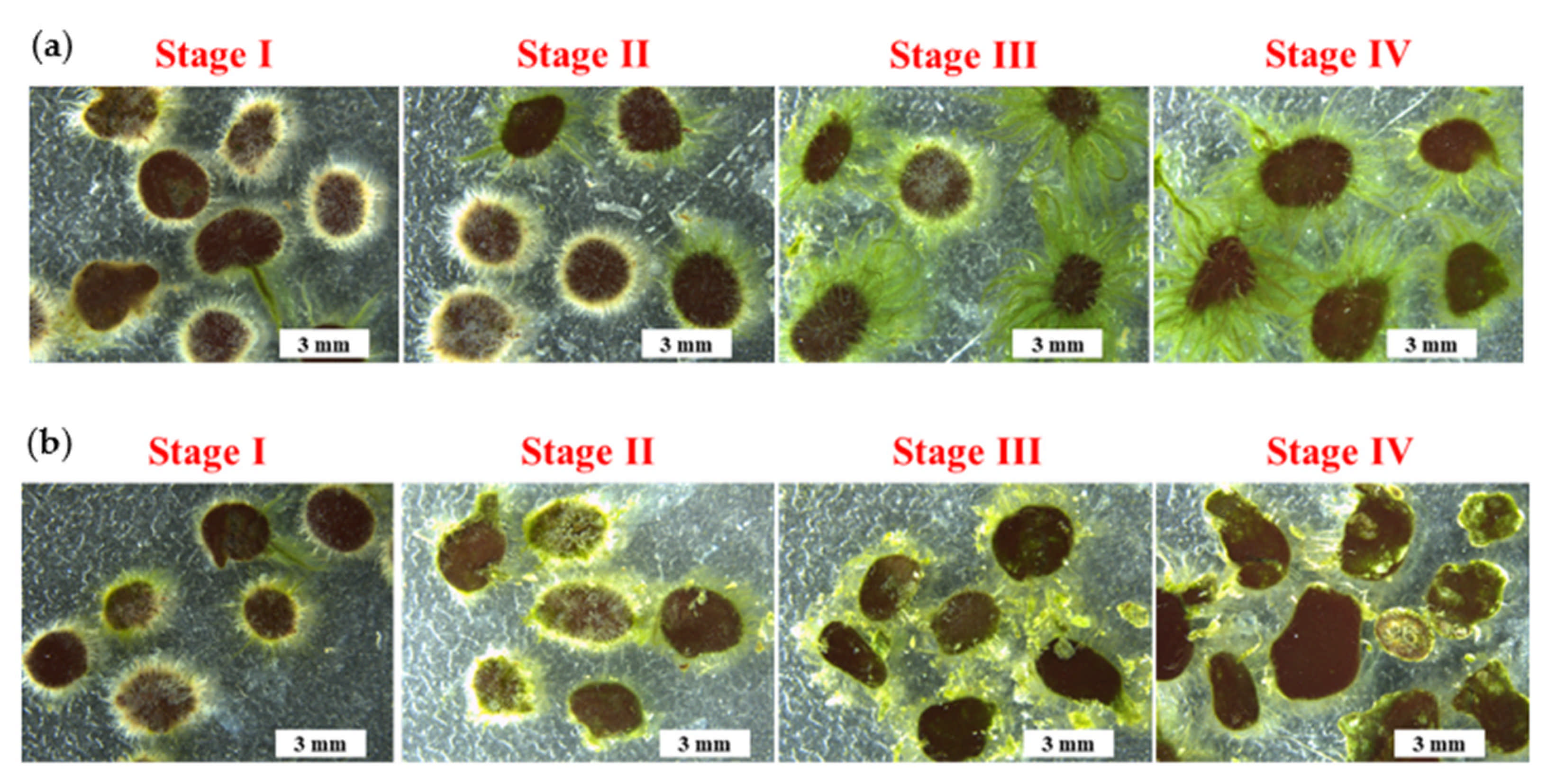
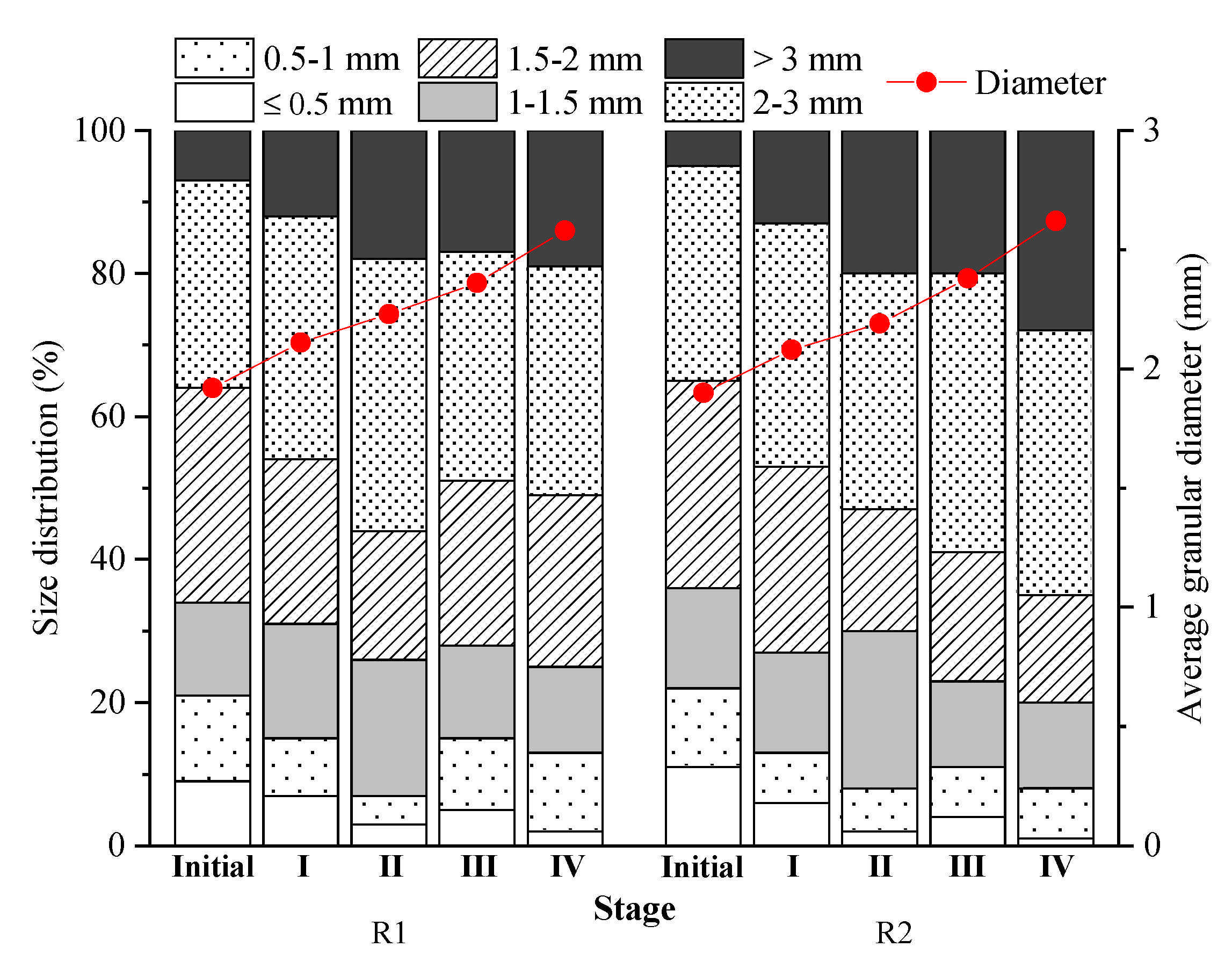
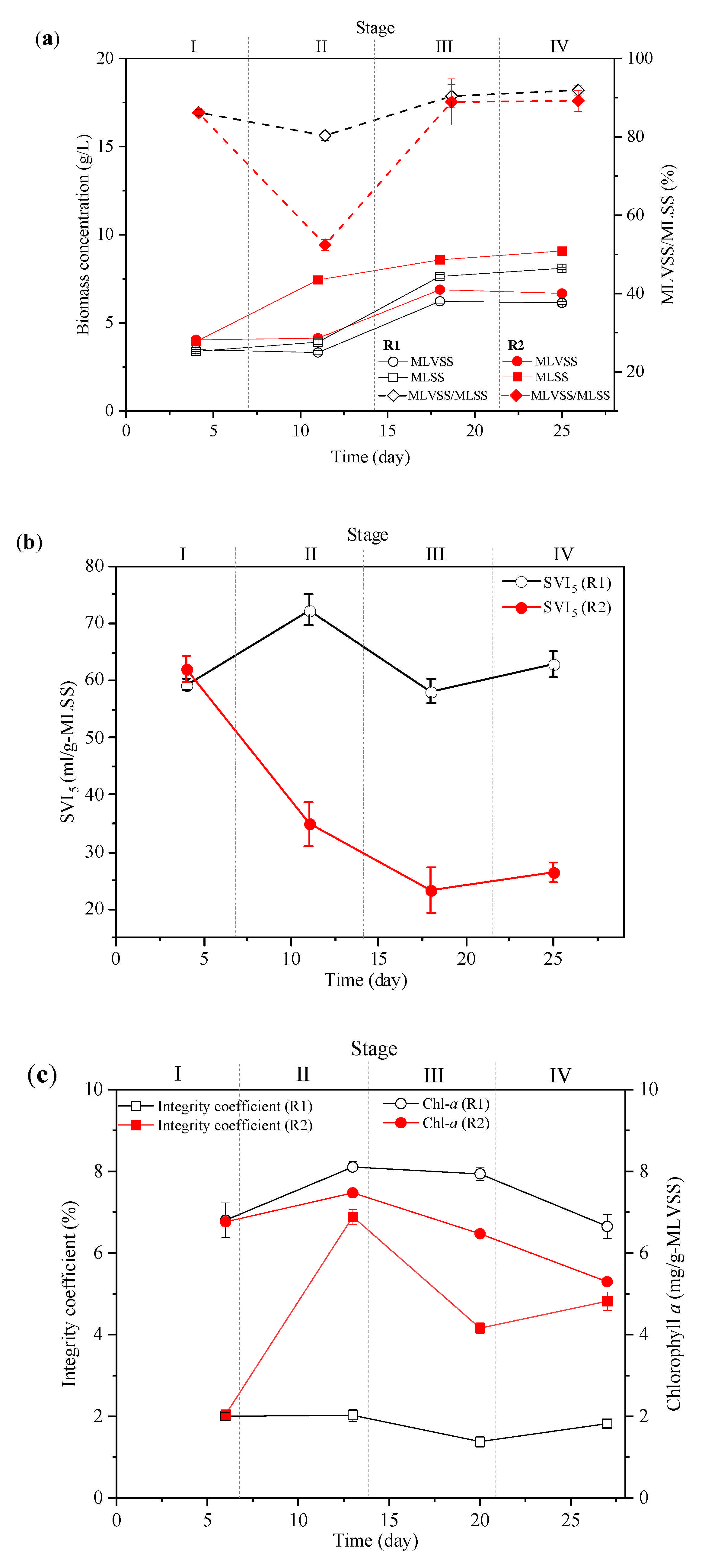
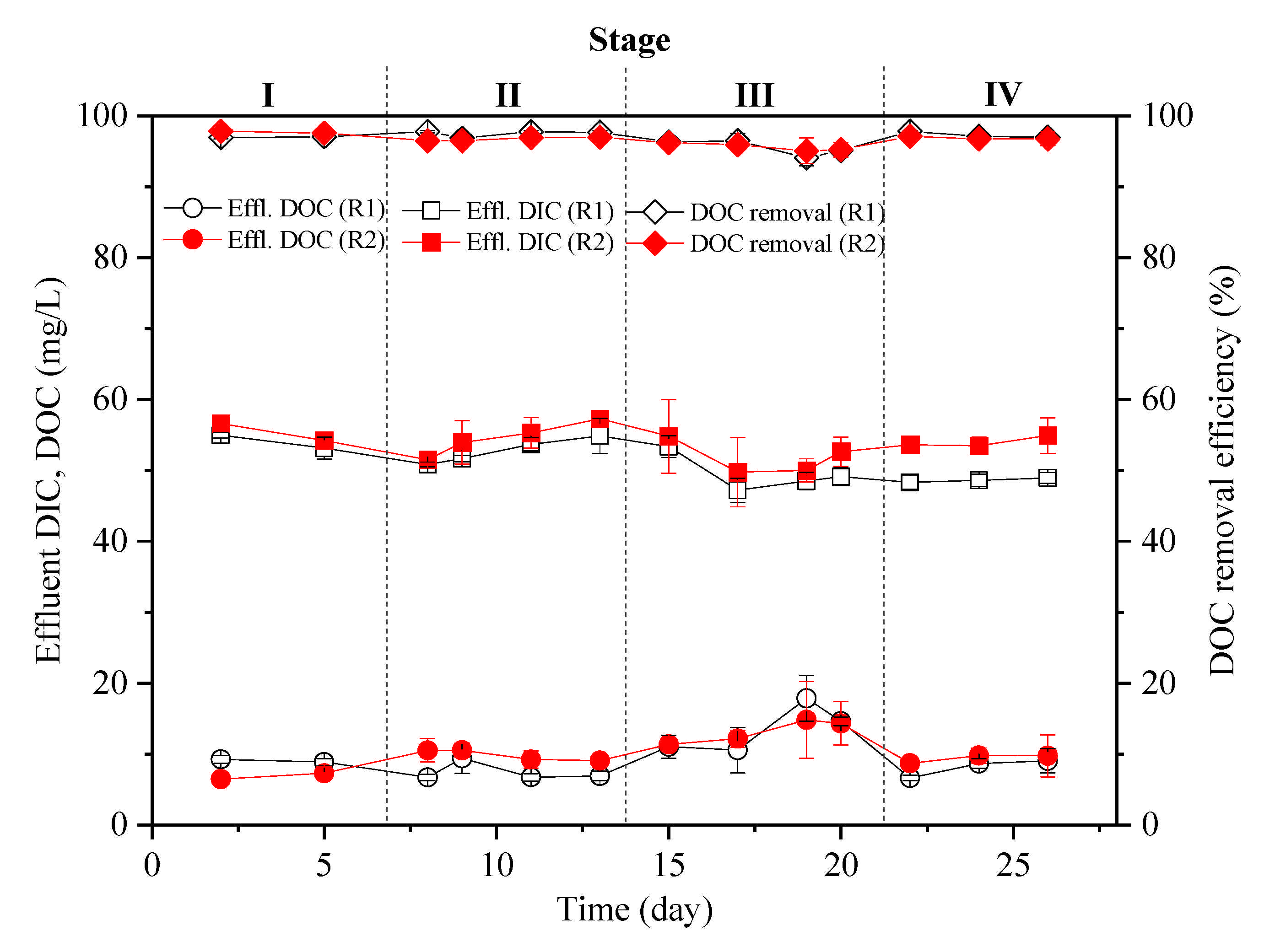
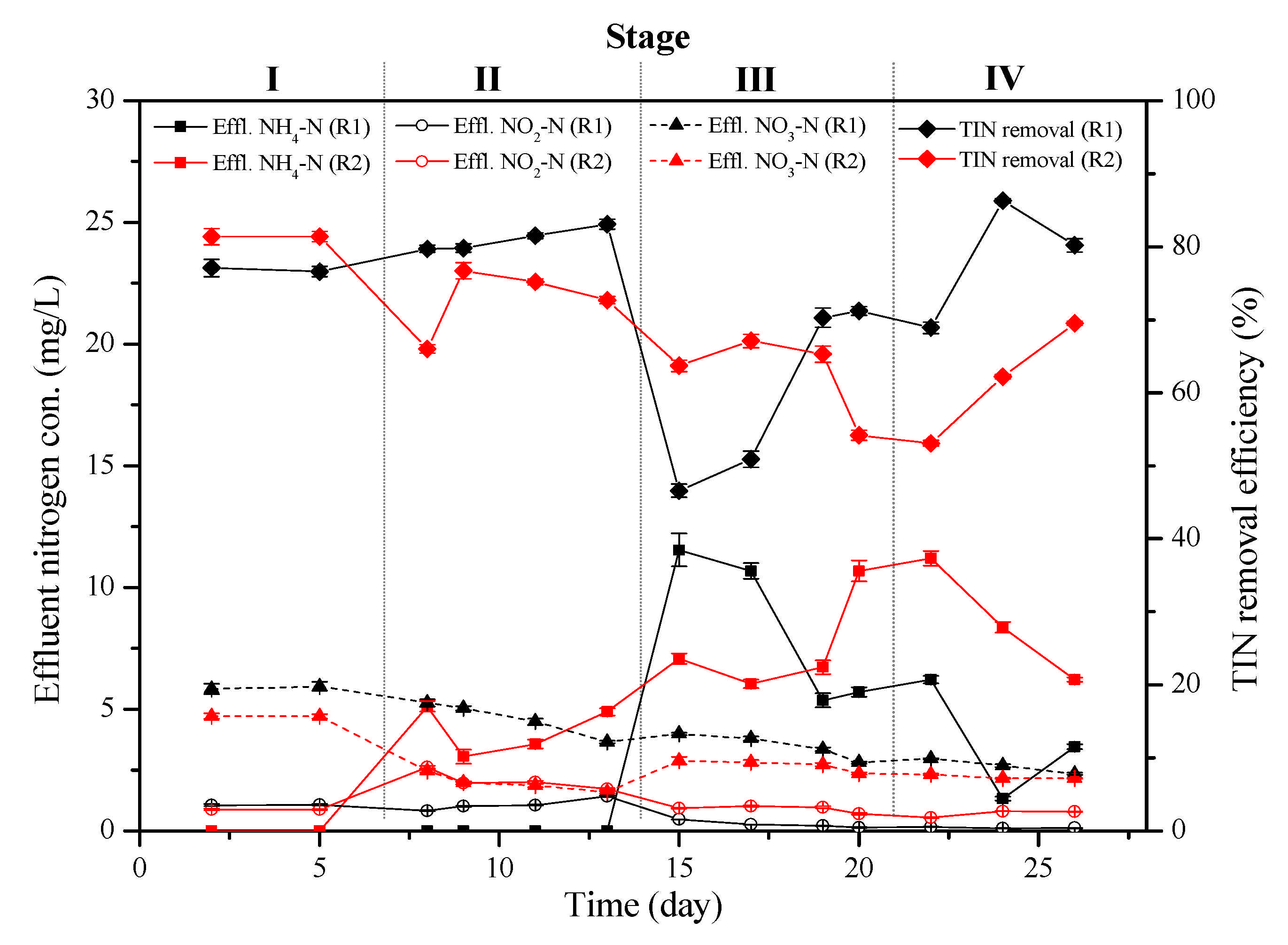
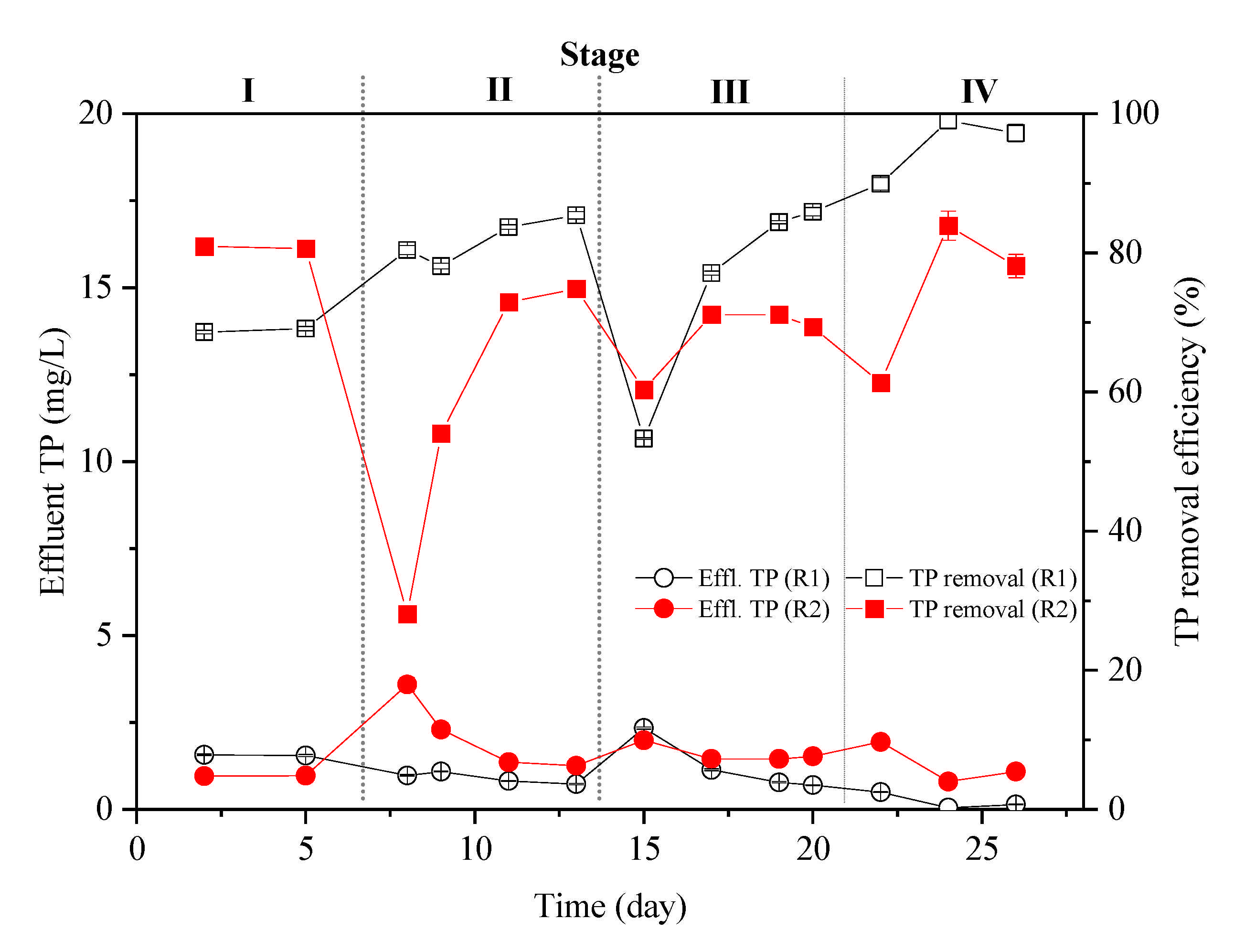
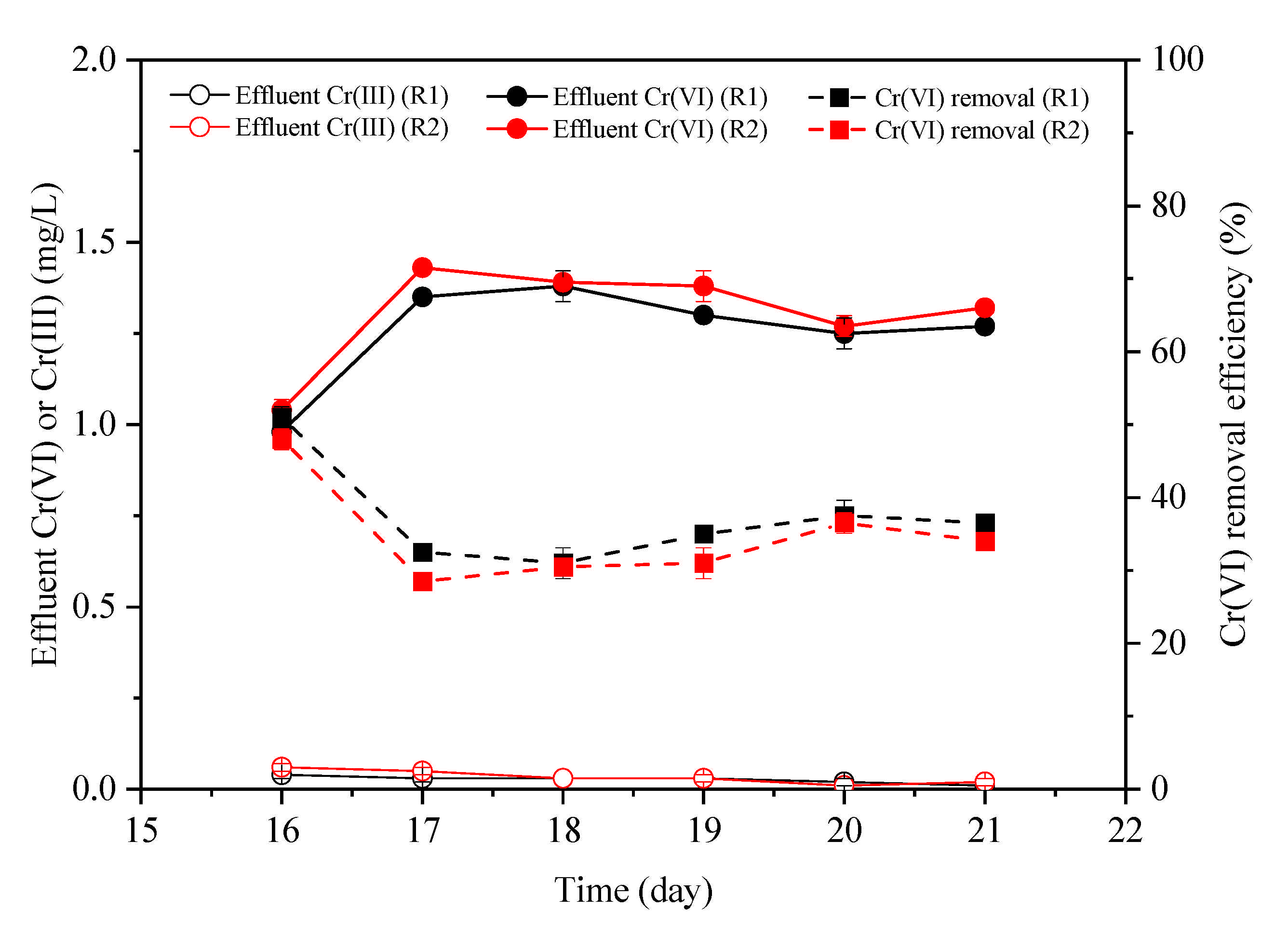
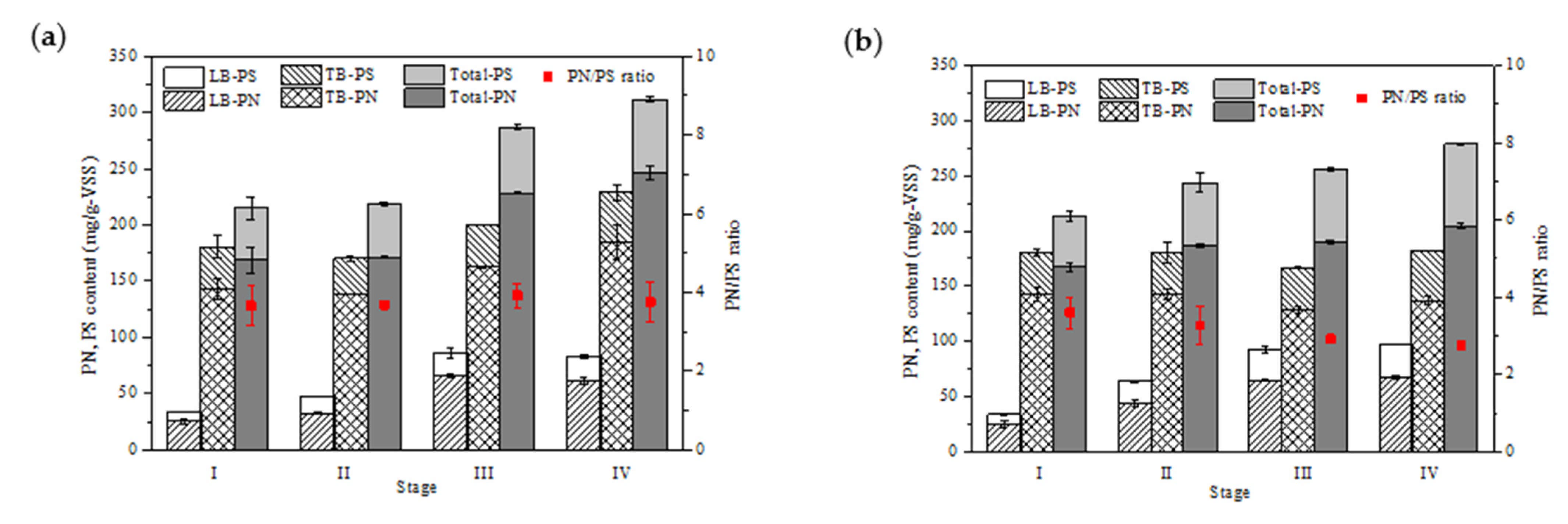
| Reactor | Salinity and/or Cr(VI) Exposure | Operation Stage | |||
|---|---|---|---|---|---|
| I (Days 1–7) | II (Days 8–14) | III (Days 15–21) | IV (Days 22–28) | ||
| R1 | NaCl (g/L) | 0 | 0 | 0 | 0 |
| Cr(VI) (mg/L) | 0 | 0 | 2 | 0 | |
| R2 | NaCl (g/L) | 0 | 10 | 10 | 10 |
| Cr(VI) (mg/L) | 0 | 0 | 2 | 0 | |
Publisher’s Note: MDPI stays neutral with regard to jurisdictional claims in published maps and institutional affiliations. |
© 2021 by the authors. Licensee MDPI, Basel, Switzerland. This article is an open access article distributed under the terms and conditions of the Creative Commons Attribution (CC BY) license (https://creativecommons.org/licenses/by/4.0/).
Share and Cite
Nguyen, B.V.; Yang, X.; Hirayama, S.; Wang, J.; Zhao, Z.; Lei, Z.; Shimizu, K.; Zhang, Z.; Le, S.X. Effect of Salinity on Cr(VI) Bioremediation by Algal-Bacterial Aerobic Granular Sludge Treating Synthetic Wastewater. Processes 2021, 9, 1400. https://doi.org/10.3390/pr9081400
Nguyen BV, Yang X, Hirayama S, Wang J, Zhao Z, Lei Z, Shimizu K, Zhang Z, Le SX. Effect of Salinity on Cr(VI) Bioremediation by Algal-Bacterial Aerobic Granular Sludge Treating Synthetic Wastewater. Processes. 2021; 9(8):1400. https://doi.org/10.3390/pr9081400
Chicago/Turabian StyleNguyen, Bach Van, Xiaojing Yang, Shota Hirayama, Jixiang Wang, Ziwen Zhao, Zhongfang Lei, Kazuya Shimizu, Zhenya Zhang, and Sinh Xuan Le. 2021. "Effect of Salinity on Cr(VI) Bioremediation by Algal-Bacterial Aerobic Granular Sludge Treating Synthetic Wastewater" Processes 9, no. 8: 1400. https://doi.org/10.3390/pr9081400
APA StyleNguyen, B. V., Yang, X., Hirayama, S., Wang, J., Zhao, Z., Lei, Z., Shimizu, K., Zhang, Z., & Le, S. X. (2021). Effect of Salinity on Cr(VI) Bioremediation by Algal-Bacterial Aerobic Granular Sludge Treating Synthetic Wastewater. Processes, 9(8), 1400. https://doi.org/10.3390/pr9081400






